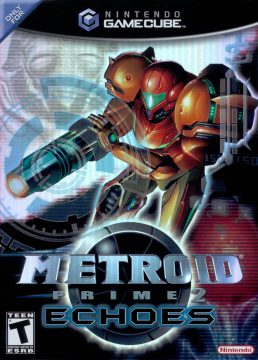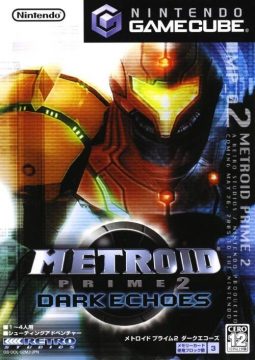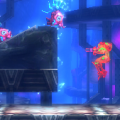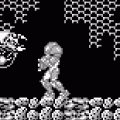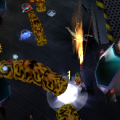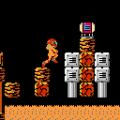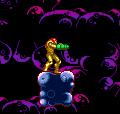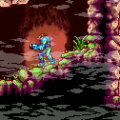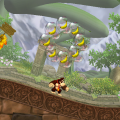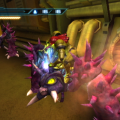The entirety of the Metroid series is covered in HG101 Digest 7: Metroid and Kid Icarus, please check it out!
Metroid Prime 2 takes place on the world of Aether, home to a race called the Luminoth. Several decades before the events of the game, a Phazon meteor crash landed into the planet, which caused the formation of a dark, mirrored, alternate dimension that became home to evil beings called the Ing. The Luminoth and Ing have been fighting a war ever since, and things haven’t been working out too well for the Luminoth. The Space Pirates who colonized Aether have also had a rough time, as well as the Federation Marines who set out to stop them, as both were wiped out by Ing assaults. Samus Aran comes to investigate and finds herself being the hero that must not only save the Luminoth civilization, but also prevent the Ing from spreading throughout the rest of the galaxy.
This sequel takes inspiration from one of Metroid‘s sister series – The Legend of Zelda: A Link to the Past. While you begin the adventure on Light Aether, you quickly find portals that will suck you into Dark Aether, the alternate world that has the same basic layout but with some substantial changes – routes that are blocked in one will be clear in the other, room layouts can sometimes be different, and some locales only exist in one and not the other. You also need to explore the Dark versions of each area to find the three keys that will unlock the boss battle and let you proceed onwards.
Dark Aether isn’t just a different map with a darker color palette, though – it’s so dark that the atmosphere is toxic, causing Samus damage simply by existing within it. To alleviate this, there are spheres of light that are posted at regular intervals, which not only protect Samus but also slowly regenerate her health. Sometimes these are stationary, allowing you to rest, but others need to be activated with a shot and collapse after a short period, and some are attached to moving creatures, so you need to move along with them to stay protected. Advancing through the dark world therefore means running quickly from sphere to sphere, trying to find safe spots as you map the territory and fight off the Ing.
The Ing are particularly terrifying foes, too. They’re not just shadowy monsters, they also possess the bodies of their victims, using them as zombie-like puppets that you must dispose of. Between these eldritch menaces and an environment that’s literally trying its best to kill you, there’s a tremendous sense of terror and menace prevalent in Metroid Prime 2. It’s not quite a horror game – it isn’t particularly gruesome, and it’s not much on jump scares either – but there’s a sense of oppressiveness that pervades the whole experience. Plus, the Game Over sequence is absolutely brutal. The version in the first game, which zoomed in on Samus’ cracked visor, was already a little unnerving, but this game shows an x-ray highlighting the failure of Samus’ heart as beeping indicates the flatlining of her vitals, before the text reads “Mission Failure”. It’s terrifying, so make sure not to die!
Rectifying one of the few shortcomings of its predecessor, the boss fights are much improved. Before obtaining any of the main power-ups, there’s a mini-boss fight against a Guardian who uses that ability, making for some interesting fights. The main bosses are quite a bit cooler too, like Amorbis, a trio of gigantic worms that bury under the ground; Chykka, an enormous insect who begins the fight cocooned, proceeds to larval form, and then grows into a dragonfly-like creature; and Quadraxis, a terrifying, multi-legged security drone. You also have a few encounters with Dark Samus, a doppelgänger formed from Phazon which was seen in the hidden ending to the original Metroid Prime. The design is cool, but since Metroid Fusion already dealt with an evil Samus in a somewhat interesting fashion, this lacks its intended impact.
New to the arsenal are the Light and Dark beams, though they function similarly to familiar weapons. The Dark Beam stuns enemies similar to the Ice Beam, while the Light Beam is a laser similar to the Plasma Beam, and both have a couple of additional charge shots. However, each is also limited in ammunition, maxing out at 50 at first but this can be expanded. Defeating an enemy with one type of gun may spawn the opposing type of ammunition, so you can always keep yourself well-stocked. Since opening certain doors requires either Light or Dark shots, you can always use one of these weapons when using a charged attack, even if you’re out of ammo. You can also find the Annihilator Beam in the late stages of the game. This is easily the most powerful weapon available and is also powered by both kinds of ammo.
The original Metroid Prime was missing the Screw Attack, as the developers couldn’t quite figure out how to make it work in 3D. They’ve solved that problem here, though functionally it’s also similar to the Space Jump from Super Metroid, allowing you to bounce mid-air several times, as well as spring off of certain types of walls. Like the Morph Ball, it’s a lot of fun to use, though it doesn’t shred through enemies quite as well as in the 2D games. There are also new types of visors: the Dark Visor lets you see objects that are stuck between the two dimensions, and the Echo Visor, which lets you see sound waves. Both of these are used in boss battles and some puzzles.
While the Dark world elements are Metroid Prime 2‘s biggest strengths, they’re also one of its biggest weaknesses. The original Metroid Prime was so effective because it was such a gorgeous game, presenting an alien world that was dangerous but fascinating. In contrast, Metroid Prime 2 is just unrelenting brutality. The hub area of the Temple Grounds show off some cool designs, but the Agon Wastes consist of little more than sand and rocks, while the Torvus Bog is one gigantic green swamp. Toss in the purple shades of the Dark Aether, and so much of the game just looks and feels gloomy. At least this is somewhat rectified by the Sanctuary Fortress, a citadel filled with high technology and a bright silver, retro sci-fi aesthetic. It also contains one of the coolest enemies in the game, a virus that infects Samus’ suit and can only be defeated by rebooting, executed via a button function.
The dual-world set up also makes navigation somewhat of a pain. Traversal in the original Metroid Prime was already a little difficult due to the 3D layouts, but when you have to work your way around two maps that are kind-of-but-not-entirely-the-same, it can get extremely confusing. Perhaps to alleviate some of this, the world design is more straightforward, with the Temple Grounds at the center and the three main areas branching out individually from there, though it ends up lacking the interconnectedness that makes Metroid’s worlds so fascinating. Much like the Artifact hunt in the first Prime, there’s a late game quest where you need to track down a number of Sky Temple keys. While the number of items here have been reduced from 12 to nine, having to retread such an enormous amount of ground feels more exhausting than it did before.
When the original Metroid Prime was released, one of the only major criticisms was the lack of a multiplayer mode. Metroid was never previously a multiplayer game, but it’s been the general assumption that first-person shooters should have them, and so one was added to Metroid Prime 2. Taking control of one of four colored Samus Arans, there are two modes: a normal Deathmatch, and Bounty, where the object is to collect as many coins as possible, either by destroying crates or knocking them out of other players. There are six arenas in total plus a number of music themes, which can be expanded by playing the single-player game. In addition to obtainable weapons, there are also machines which provide a randomized benefit, like invisibility or super strength. Despite the effort, this mode isn’t really much fun, as the controls just weren’t made for competitive multiplayer, especially in the GameCube version. Neither the GameCube or Wii versions had online multiplayer, either.
Metroid Prime 2 is definitely an acquired taste – it’s darker and moodier, and certainly effective at eliciting fear and tension, but while the original game was often enchanting, this one can end up feeling depressing in comparison. Furthermore, having two worlds to explore is definitely a little too overwhelming, especially since there’s no way to fast travel around to different areas. Still, the fact that Retro Studios tried experimenting with this entry shows that they weren’t content to merely create a safe sequel – for those that gel with its brutal vibes, they may find their favorite entry in the Prime series.
Unlike the original, there haven’t been quite as many variations of Metroid Prime 2. The version featured in the Wii Trilogy release adds in the Spring Ball jump function, which also makes the fight against the Spider Guardian miniboss much easier. Considering that this was an unnecessarily difficult fight in the GameCube release, this makes the Trilogy version preferable. The easier difficulty mode added to this version helps, as well.

